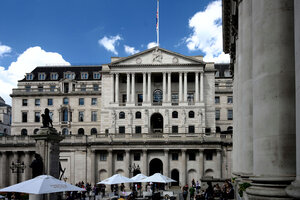
Situated adjacent to St. Paul’s Cathedral, our reworking of this six-storey neo-classical building has created 116,000 sq ft of high-quality office space, three levels of communal terraces and a large new garden designed by Tom Stuart-Smith
Buckley Gray Yeoman, 2022

Built in 1836, Atlas House is the former Headquarters of a global insurance company. Located on the corner of King Street and Cheapside, Atlas House, with its Italianate architectural features, distinctive clock and sculpture of Atlas poised above the grand entrance, is one of the last Georgian-era buildings still standing in the heart of The City.
Thomas Hoopper, 1836

The museum is part of the Bank of England rebuilding in the 1930's by Sir Herbert Baker. One room is a reconstruction of 1793 Bank of England Stock Office by Sir John Soane.
Sir John Soane, Sir Herbert Baker, 1925

London's main tourist information centre is clad in a specially manufactured system of 220 pre-finished stainless steel panels. The subtly reflective surface provides a striking counterpoint to St Paul's.
Make Architects, 2007

Architectural showspace on the first floor of a duplex unit in the City’s Royal Exchange (the ground floor houses clothing boutique, GOFF COURTNEY, which also sells accessories, visual books & magazines. INTERMISSION is exhibiting three-dimensional artworks by architect Misha Stefan and RE:PLACE – proposing alternative, more inclusive destinations for three prominent gateway sites in the City.
William Tite, 1844

The church was first mentioned c1080 and is the oldest of the City churches dedicated to St Mary. It became a Guild Church by virtue of the City of London (Guild Churches) Act, 1952. It is the only Wren church built in the Late Gothic style after the Great Fire of London, 1666, thanks to a bequest.
Sir Christopher Wren, 1677

Founded by William the Conqueror's Archbishop Lanfranc in 1080 (the significant crypt survives) St Mary-le-Bow was rebuilt, notably by Wren after the Great Fire and by Laurence King in 1964 after WWII destruction. Home of Bow Bells.
Sir Christopher Wren, 1683

Guided tours of the Triforium space to see: items from the cathedral collections including Christopher Wren’s magnificent ‘Great Model’ made in 1673; the recently conserved Library; the Geometrical Staircase and the stunning view from the West Gallery.
Sir Christopher Wren, 1710

12C church. During the Great Fire of 1666 the church building escaped total destruction, and was restored. Christopher Wren was eventually called in to rebuild St Vedast, completing the work in October 1673.
Sir Christopher Wren, 1170

Temple Bar is a 350 year old gateway to the City of London, designed by Sir Christopher Wren. It formerly stood in Fleet Street, and is the last surviving gateway to the City of London. This beautiful structure has a fascinating history, which will be revealed to visitors.
Sir Christopher Wren, 1672
